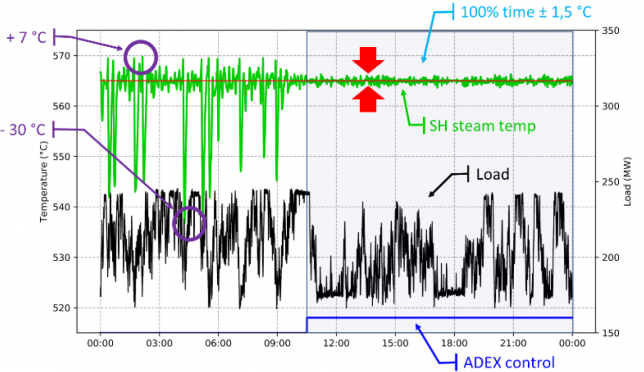Using AI for flexibility at hydrogen-ready CCPP
The power generation sector is transitioning fast, and higher flexibility requirements will be needed to generate intermittent renewable energy.
For instance, Bizkaia Energia, the owner of the Amorebieta 2x1 CCGT generation plant in Spain, developed a plan to adapt the operational flexibility and performance that enable them to stay longer in the market or to return earlier. The 786 MW plant consists of two GE MS9001 FA DLN 2.0+ gas turbines and an ALSTOM DKYZZ3-2N41 steam turbine.
The Amorebieta power plant has been operating in AGC mode, cycling more than 30% of load an average of 150 times per day. In this demanding operating context, the unstable steam temperatures represented a constrain to steepen the plant ramp rate, to decrease the minimum load, and to reduce the thermal stress.
The Amorebieta power plant is next door to a major green hydrogen production project. The goal is to generate 1,500 tons of green hydrogen per year exclusively from renewable sources. A portion of the green hydrogen will be used in the Amorebieta plant. The project is expected to begin operations in 2022.
Higher performance and lower thermal stress
The Amorebieta plant continuously had peaks of +7°C and drops of up to -30°C in SH and RH steam temperature during AGC operation. Ever since ADEX Optimizers for SH and RH were implemented, the temperature is kept ±1.5°C around the setpoint during 100% of the time, even in AGC operation mode. As a result of the stabilization, the average steam temperature has increased 4.8°C, which implies a heat rate reduction of 0.12%.
ADEX Self-tuning AI enable thermal power plants to achieve the essential flexibility improvements to become more competitive in the increasingly demanding power generation markets.

ADEX Optimizer eliminates thermal fatigue and overshoot.[/caption]
Due to the improvement of the control performance, the plant has taken a step further. ADEX as implemented an optimization setpoint control that increases the steam temperature 2.1°C, reducing the rate an additional 0.05%. Keeping the temperature in a narrow band leads to a reduction of the induced thermal stress on superheater headers and steam turbines, which increases the equipment life expectancy and the plant availability.
Enhanced dispatchability: higher ramp rate and lower minimum load
The main goal of Bizkaia Energia was to enhance its dispatchability in two ways – a faster ramping load and a reduction on the minimum load of the plant.
Bizkaia Energia gas turbines may reduce the minimum load from 270 MW to 205 MW, however, the downstream steam cycle made this operation impossible due to steam attemperator overshoots when ramping down. After commissioning ADEX Optimizers, the overshoots were eliminated, enabling in 1+1 operation a ramp rate increase from 15 MW/min to 24 MW/min and a minimum load reduction up to 205 MW. These achievements have been possible thanks to ADEX Self-tuning AI keeping the superheated steam temperature withing the ±1.5°C band 100% of the time during any operating condition.
Combustion challenges
Higher ramp rates and lower minimum loads produce more demanding combustion conditions in the gas turbines. And this is not the only challenge facing BE gas turbines. Once a combustion turbine is tuned to burn a specific gas composition, changes in gas type affect flame stability, NOx formation, and combustion dynamics. With rising LNG imports, the frequency and magnitude of variations in fuel composition have increased, impacting the Wobbe index.
Current technologies are not providing enough accuracy in the gas temperature control, limiting flexibility, and increasing runback risks. ADEX Gas Heater Optimizer controls it five times more accurately, enabling BE gas turbines to meet the demanding conditions resulting from the flexibility increase and the varying fuel compositions while maintaining flame stability, reducing the dynamics and eliminating the trip risks.
Improvements in startups and equipment life
ADEX Steam Temperature Optimizers eliminate temperature excursions and oscillations during the startup. This has enabled BE to operate with the optimal steam temperature setpoint sequence for the steam turbine warm-up. As a result, rotor stress limits are not exceeded and steam turbine lifetime consumption is reduced.
Fuel Flexibility in Heavy-Duty Gas Turbines: A Key Driver for Energy Transition
March 13th 2025From Hydrogen to HVO, Mr. Federico Bonzani, Chief Technology Officer of Ansaldo Energia, describes the fuel flexibility state-of-the-art solutions of the Company to meet the actual and future needs of power generation industry.